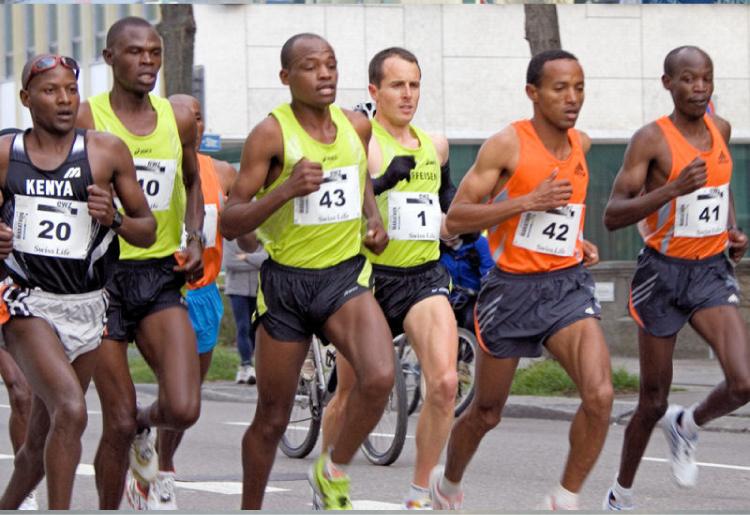3.4 Types of Muscle Fibers
Learning Objectives
By the end of this section, you will be able to:
- Describe the types of skeletal muscle fibers
- Explain fast and slow muscle fibers
Two criteria to consider when classifying the types of muscle fibers are how fast some fibers contract relative to others, and how fibers produce ATP. Using these criteria, there are three main types of skeletal muscle fibers. Slow oxidative (SO) fibers contract relatively slowly and use aerobic respiration (oxygen and glucose) to produce ATP. Fast oxidative (FO) fibers have fast contractions and primarily use aerobic respiration, but because they may switch to anaerobic respiration (glycolysis), can fatigue more quickly than SO fibers. Lastly, fast glycolytic (FG) fibers have fast contractions and primarily use anaerobic glycolysis. The FG fibers fatigue more quickly than the others.
The primary metabolic pathway used by a muscle fiber determines whether the fiber is classified as oxidative or glycolytic. If a fiber primarily produces ATP through aerobic pathways it is oxidative. With the use of oxygen, more ATP can be produced during each metabolic cycle, making the fiber more resistant to fatigue. Glycolytic fibers primarily create ATP through anaerobic glycolysis, which produces less ATP per cycle, but does not require oxygen to do so. As a result, glycolytic fibers fatigue at a quicker rate.
The oxidative fibers contain many more mitochondria than the glycolytic fibers, because aerobic metabolism, which uses oxygen (O2) in the metabolic pathway, occurs in the mitochondria. The SO fibers possess a large number of mitochondria and are capable of contracting for longer periods because of the large amount of ATP they can produce, but they have a relatively small diameter and do not produce a large amount of tension. SO fibers are extensively supplied with blood capillaries to supply O2 from the red blood cells in the bloodstream. All of these features allow SO fibers to produce large quantities of ATP, which can sustain muscle activity without fatiguing for long periods of time.
The fact that SO fibers can function for long periods without fatiguing makes them useful in maintaining posture, producing isometric contractions, stabilizing bones and joints, and making small movements that happen often but do not require large amounts of energy. They do not produce high tension, and thus they are not used for powerful, fast movements that require high amounts of energy and rapid cross-bridge cycling.
FO fibers are sometimes called intermediate fibers because they possess characteristics that are intermediate between fast fibers and slow fibers. They produce ATP relatively quickly, more quickly than SO fibers, and thus can produce relatively high amounts of tension. They are oxidative because they produce ATP aerobically, possess high amounts of mitochondria, and do not fatigue quickly. FO fibers are used primarily for movements, such as walking, that require more energy than postural control but less energy than an explosive movement, such as sprinting. FO fibers are useful for this type of movement because they produce more tension than SO fibers but they are more fatigue-resistant than FG fibers.
FG fibers primarily use anaerobic glycolysis as their ATP source. They have a large diameter and possess high amounts of glycogen, which is used in glycolysis to generate ATP quickly to produce high levels of tension. Because they do not primarily use aerobic metabolism, they do not possess substantial numbers of mitochondria. FG fibers are used to produce rapid, forceful contractions to make quick, powerful movements. These fibers fatigue quickly, permitting them to only be used for short periods. Most muscles possess a mixture of each fiber type. The predominant fiber type in a muscle is determined by the primary function of the muscle.
|
|
Slow Oxidative (SO) Fibers |
Fast Oxidative (FO) Fibers |
Fast Glycolytic (FG) Fibers |
|
Metabolic Pathway |
Aerobic respiration: uses oxygen to create ATP |
Primarily aerobic respiration, but can switch to anaerobic glycolysis |
Anaerobic glycolysis: breaks down glucose to produce ATP without requiring oxygen |
|
Fatigability |
Slowest to fatigue |
Quicker to fatigue than SO fibers |
Quickest to fatigue |
|
Speed of Contraction |
Relatively slow contraction |
Fast contraction |
Fast contraction |
|
Amount of Tension Produced |
Low |
High |
Highest |
Exercise and Muscle Performance
Most skeletal muscles in a human contain(s) all three types of muscle fibers, although in varying proportions. There are many factors that play a role in the proportion of each fiber type in any given muscle.
One important factor is how the muscle is trained.
Endurance Exercise
Slow fibers are predominantly used in endurance exercises that require little force but involve numerous repetitions. The aerobic metabolism used by slow-twitch fibers allows them to maintain contractions over long periods. Endurance training modifies these slow fibers to make them even more efficient by producing more mitochondria to enable more aerobic metabolism and more ATP production.

Resistance Exercise
Resistance exercises, as opposed to endurance exercise, require large amounts of FG fibers to produce short, powerful movements that are not repeated over long periods. The high rates of ATP hydrolysis and cross-bridge formation in FG fibers result in powerful muscle contractions. Muscles used for power have a higher ratio of FG to SO/FO fibers, and trained athletes possess even higher levels of FG fibers in their muscles.


